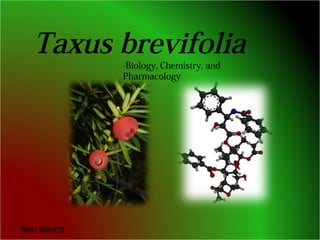
T. brevifolia 2
- 1. Taxus brevifolia Ben Merritt -Biology, Chemistry, and Pharmacology
- 2. Taxus (Taxaceae) - Evergreen trees or shrubs; not resinous or aromatic Roots – fibrous, woody Leaves – needles, persist for several years (evergreen), spirally arranged (alternate), resin canals may be present or absent Bark – scaly or fissured -6-10 species --- mostly unique because of geographical location
- 3. Taxus Growth Forms T. chinensis T. bacata“Repandens” T. bacata“Little Gem” T. brevifolia var. reptaneta
- 4. Taxus Seeds – one per “cone,” surrounded by fleshy aril Pollen Cones – produced annually, axillary, globose/ovoid - Reproductive Structures Seed Cones – 1-2 ovules, axillary T. cuspidata - Aril is edible but seeds are toxic
- 5. T. brevifolia Anatomy-shrub/small tree 15-25m tall (200y to mature) -dioecious -bark scaly; outer scales purplish/brown -branches horizontal/droopi ng -vegetative reproduction common -inner scales reddish/purp le -leaves 1-2cm x 1-4mm -epidermal cells mostly taller than wide -seeds mature late summer/fall
- 6. Habitat -Western NA – Alaska south to Montana, Idaho and California - Lives in moist areas around river banks, ravines -Sea-level to 2200m -May grow in sun or shade (needs acclimation period)
- 7. Common Names The only common names seem to be “Pacific Yew” and “Western Yew.” - “yōl’-kō” in Concow language (CA)
- 8. Latin Name Taxus brevifolia (Nutt.) brevi - = short, abbreviated -folia = foliage; leaves ↵1. Loanword of Scythian (Iranian) origin; means simply “yew” in Latin 2. From the Greek, meaning “bow”; origin of word “toxic”
- 9. Traditional Uses -Was sometimes used in Native American (Algonquin) smoking mixtures called kinnikinnick -Needles of Taxus with uva- ursi plant said to produce “too strong of an effect” -Wood was used by Native American tribes to make bows -Used similarly by the ancient Greeks/Roman s – considered toxic
- 10. Modern Uses -Originally found to have cytotoxic effects on cancer cells (antineoplastic) -Less toxic than other species, most taxol Used on a variety of cancers (breast, ovarian, lung, colon, leukemia) -Often 24-h infusion every few weeks
- 11. Parts used Primarily the bark and leaves (active constituents in phloem) -Was initially tested against KB cells (HeLa derivatives); have carcinoma and papilloma cancers Order of potency (extract) stem > bark > root > needles > wood >twigs -Needles first require non- polar wash to remove fats (then CO2, or other) T. cuspidata
- 12. Constituent s - Taxol – Isolated first in 1966 by Wall and Wani (0.02%, dried bark) Contains variety of Taxanes – taxol most active
- 13. Mechanism of Action Microtubule (MT) stabilization -Beta-tubulin binding only -Promotes assembly, discourages depolymerization -Prevents mitosis, eventual cell death
- 14. Undesirable Effects of Taxol Administration (Long-term) Causes build-up of MT’s Effects rapidly- dividing cells – gut, bone marrow, lymphocytes -Hypersensitivity (allergic reaction) -Mostly due to vehicle (cremophor) – some use albumin -Peripheral Neuropathy (doses greater than 170mg/m2 ) – also may result from cremophor -Neutropaenia -Problems with heart (arrythmia, bradycardia) -Vomiting -Mucositis (dig., painful) -Dysphagia
- 15. Isolation/Synthe sisFrom the bark (0.01-0.02%): MeOH, then methylene chloride/H20 (or chloroform) From the needles (0.025-0.044%): Hexane pre-wash (waxes, lipids) - [ ] in bark rises over summer - Concentration increases in plant material after letting sit for a week or two Hauser Chemical used 15,000lb of bark for 1kg of taxol (0.015%) Semi-synthetic route (80%) 10-deacetlybaccatin III Total synthesis possible
- 16. Other Methods of Isolation Plant Cell Fermentation: Grow Taxus calluses in aqueous media, extract taxol (chromatography, crystallization) -Bristol-Myers Squibb Endophytic Fungi? -Taxomyces andreanae Original study – (1993) -15-20% of taxanes is taxol -24-50ng/liter -May require precursors Later study – (2013) -Not found to have homologous genes/evidence of trans-kingdom gene transfer - Thought to remain in membrane after
- 17. The Future Taxol and related taxanes are useful in the treatment of cancer, but they have many terrible side effects. Further research should be centered around: 1. Molecules with less toxic effects 2. Specific cell targeting (work is being done with IG) 3. Better vehicles for administration (albumin, pro- drug)
- 18. • ATCC. “KB (ATCC® CCL-17TM ).” <http://www.atcc.org/products/all/CCL-17.aspx> May 1 2014. • EPA. “Greener Synthetic Pathways Award: Bristol-Myers Squibb Company.” <http://www2.epa.gov/green-chemistry/2004-greener- synthetic-pathways-award> Last updated 16 March 2014. • Hagiwara, H. and Y. Sunada. “Mechanism of Taxane Neurotoxicity.” Breast Cancer. Vol. 11(1): pp. 82-5. 2004. • Heinig, U., S. Scholz, and S. Jennewein. “Getting to the Bottom of Taxol Biosynthesis by Fungi.” Fungal Diversity. Vol. 60: pp. 161-170. 9 April 2013. • Itokawa, H. and Kuo-Hsiung Lee. Taxus: The Genus Taxus. New York: Taylor and Francis, 2003. eBook. • Lowe, J., H. Li, K.H. Downing, and E. Nogales. “Refined Structure of αβ-Tubulin at 3.5 Å Resolution.” Journal of Molecular Biology. Vol. 313(5): pp. 1045-57. 9 November 2001. • Markman, M. “Taxol: An Important New Drug in the Management of Epithelial Ovarian Cancer.” The Yale Journal of Biology and Medicine. Vol. 64: pp. 583-90. 26 March 1991. • Mitchell, A.K. “Acclimation of the Pacific Yew (Taxus brevifolia) Foliage to Sun and Shade.” Tree Physiology. Vol. 18: pp. 749-57. 1998. • Morin, N. R. Flora of North America: Volume 2: Pteridophytes and Gymnosperms. Edited by Flora of North America Editorial Committee. Toronto: Oxford University Press, 1993. eBook. • Sarosy, G., and E. Reed. “Taxol Dose Intensification and Its Clinical Implications.” Journal of the National Medical Association. Vol. 85(6): pp. 427-31. 1993. • Stierle, A, G. Stobel, and D. Stierle. “Taxol and Taxane Production by Taxomyces andreanae, an Endophytic Fungus of Pacific Yew.” Science. Vol. 260: pp. 214-216. 9 April 1993. • Suffness, M. Taxol Science and Applications. Boca Raton: CRC Press LLC, 1995. eBook.